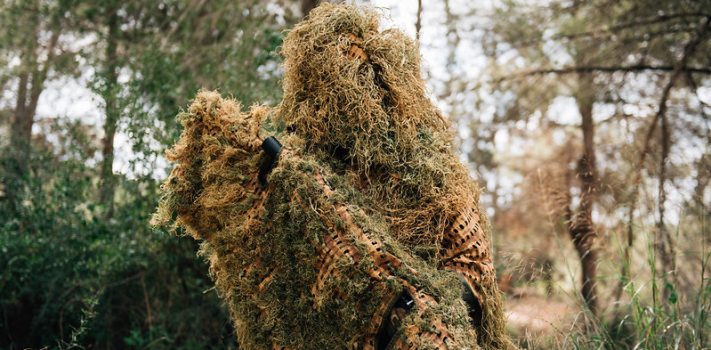Note: This is an update to an article that I wrote for SurvivalBlog, back in September of 2005. I found that many of the included links had expired, so I have updated them. I’ve also added some important details.
—
Back in the 18th century, game wardens in Scotland were engaged in an occasionally deadly game of cat and mouse with poachers. These wardens–called “ghillies” in the local parlance of the day were experts in field craft. To catch a poacher was difficult, so the ghillies would cut tree or bush limbs and cover themselves with them as camouflage while laying in wait. This was laborious but worked well. Then a warden whose name is lost in history came up with a clever idea: A camouflage body suit that was made of shredded rags in dull earth-tone and foliage-toned colors. From any distance, the man wearing it resembled a bush, and could not be easily recognized. Thus was born the Ghillie Suit.
The first use of ghillie suits by military organizations recorded by historians was during WWI, when Scottish ghillies serving with Lord Lovat’s Scouts brought their camouflage suits with them for the fighting in the fields of France. The ghillies in the Lovat Scouts shared their expertise in stalking, long-range shooting, and camouflage, which spread to other British Commonwealth armies.
The modern ghillie suit, re-popularized in the late 20th century in the British and U.S. armies is now standard wear for sniper teams in most western armies. These modern ghillie suits use the same concept, providing four key attributes: they look like plant foliage, they occupy three dimensions (unlike camouflage printed cloth), they break up a soldier’s distinctive silhouette, and they muffle noise. There are two common designs:
- A full ghillie suit, which is usually made by sewing ghillie garnish (typically strips/bundles of dyed burlap, jute, and/or hemp) to a set of green mechanic’s overalls or to a BDU shirt and trousers
- A ghillie cape, which is draped over the head and shoulders like a poncho.
I prefer the latter, especially in warm climates. Both designs are almost always used in conjunction with a camouflage face veil and a boonie-type hat with similar ghillie material garnish. Weapons can also be lightly festooned with ghillie garnish. Just be careful not to block your view of optics and/or impede operating a weapon’s action or impede changing magazines. So most of the garnish should go on the barrel and on the sides and bottom of the buttstock. Use it very sparingly, elsewhere.
Ghillie suits and capes are commercially made, but these tend to be very expensive (since they are labor-intensive to assemble) and the choice of colors used will not always match your local terrain. Avoid the cheap commercial ghillie suits that are made out of plastic. They are indeed three-dimensional but they do not blend in well in the boonies compared to natural materials like burlap and jute. They also tend to be reflective to infrared (IR). So that would make you stand out, if an opponent is using active IR night vision equipment.
Thermal Night Vision?
As for camouflage from users of thermal night vision optics, a mylar space blanket sandwiched between two nylon ponchos works fairly well. Sadly, the commercially-made thermal camouflage gear made by both Snakebite Tactical and Max VelocityTactical (MVT) seems to be out of production. But Intermat, a company in Athens, Greece, now makes thermal night vision camouflage capes and suits.
Some commercial sources include:
- Custom Concealment
- The Ghillie Suits
- And for our Australian readers, see: KitBag.com.au
Make Your Own!
Do It Yourself (DIY) ghillie suit/cape construction resources on the web include:
U.S. Army FM 23-10: http://www.globalsecurity.org/military/library/policy/army/fm/23-10/ch42.htm
Snipercountry.com: Constructing your ghillie suit
There are also fairly detailed ghillie suit-making instructions in one of my favorite books, The Ultimate Sniper.
If you want to save money and assemble all of the individual materials yourself, rather than buy a commercially-made assembly kit:
Heavy duty black or brown nylon netting–such as deep sea fishing net material — (the 1.5-inch square mesh works best) is often found for sale on eBay.
I still see fairly inexpensive military surplus rolls of 1.5″ wide burlap that is already dyed green and brown available at gun shows, but it is becoming less common. However, there is a lot of burlap material available via eBay and Etsy. You can also find burlap in sheets available at any large fabric stores, such as Jo-Ann fabrics. Do your best to buy burlaps in colors that will match your local foliage.
Avoid buying any black material. Black is a color only rarely seen in nature, so it stands out.
Burlap in sheets can easily be cut into strips. Be sure to buy burlap made of natural fibers, rather than nylon. Natural burlap can be re-dyed, to match your local colors. Using needlenose pliers to strip out most of the horizontal crossbars (this is properly called “weft”) is time-consuming, but it is necessary to make burlap frizz up into a proper three-dimensional look.
Two more points, in closing: Don’t overlook the need to integrate a hydration pack (such as a CamelBack or clone thereof) with a drinking tube when you build your ghillie suit. (This is not a big issue with a cape, but it is with a full ghillie suit.)
It is also very important that you thoroughly soak your completed ghillie suit in flame retardant and let that dry before using it. Without it, all of that frayed burlap is a fire accident that is just waiting to happen! In my experience, the FlameCheck brand retardant (made to protect theatrical curtains) works well, because it does not leave a white residue like some other brands.










